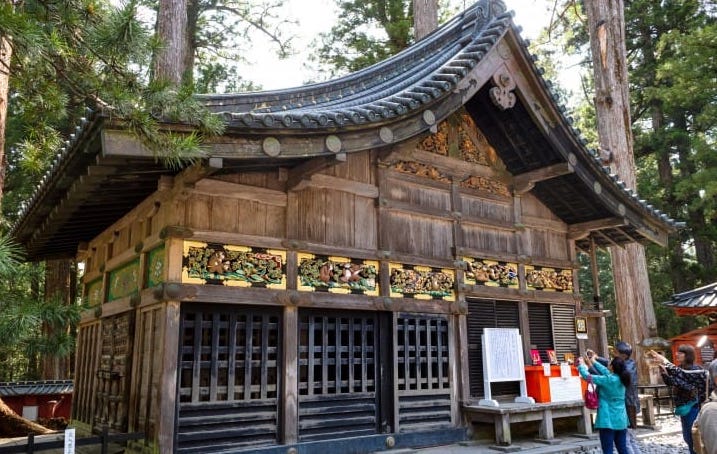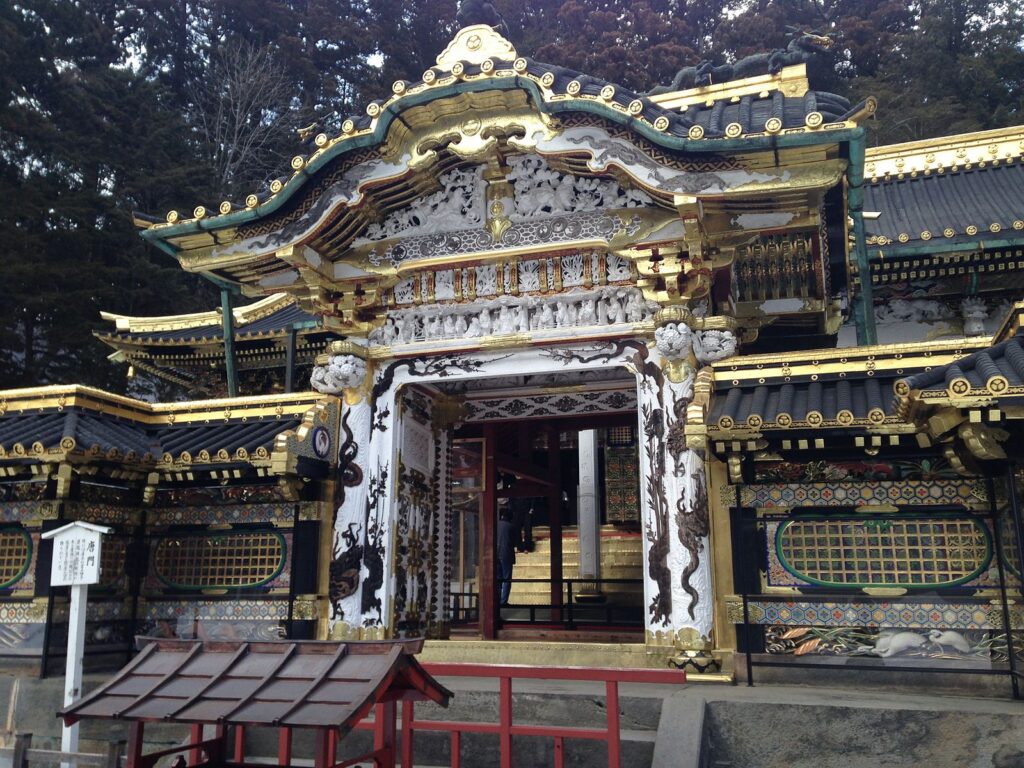Paeten Parker
The Nikko Tosho-gu shrine is “home” to the Japanese Tokugawa shogunate who ruled Japan for many years. Tokugawa was one of the most influential men in Japan who first seized power in 1589. The journey to his reign was through a lot of heartache and murder. He was kidnapped at a young age and used as bait to out his own father. It is critical to understand the importance of this powerful shogunate, the Tokugawa shogunate won the empire by retreating it. As time went by and Ieyasu began more afraid of death he order that a small shrine be constructed at the base of the Nikko Mountains. Over the years this “small shrine” became bigger as the Tokugawa shogunates successors built on to it. It now exists as a compound of more than fifty different structures big and small carved with intricate structures of monkeys, dragons, and more. The shrine or more importantly the Nikko city the trees leading up to the shrine were planted in the 1600s not too long after the construction of the shrine began. There is also a total of 15,000 trees planted on these thirty-seven kilometers of road. For my exhibition, I have chosen to showcase five buildings within the Nikko Tosho-gu shrine. My interest was sparked not solely from the visual appearance of the buildings themselves but also the significance and history behind what you see. Now I already explained the history and how the Nikko Toshu-gu Shrine came to be but what is also important is the use of color and carvings on the structures. The first structure is the Nikko Padoge which is a five-story padoga it features a curved, elongated roof a traditional Japanese architecture, and a focal point in most buildings. The use of red, a sacred color in Japan is highly prevalent throughout the building and its display of intricate designs adds even more. Next, the Yomeimon Gate is known for its grand display and extravagant apperance. Also inscribed with intriqute design and sculptures. Previously Gomadoh Hall also known as Prayer Hall but now Kamishamushmo Hall is where the chief Buddiest priest would pray for world peace during the Edo Period. The Shinkyusha meaning divine stable was waid to contain horse which wer considered divine. This stable is carved with scuptures with many different meanings. Lastly, the Karamon Gate situated directly in front of the Prayer Hall, known for its signiture arched roof and sacred carvings. All five of these marvelous buildings are located in the Nikko Tosho-gu shrine in Nikko, Japan. And, beacsue of their extravagant beauty this shrine is one of the most popular tourist locations in all of Japan. From the physicial appreance to the beautiful meaning behind everything you see is whhat makes this place so special.

Title: Yomeimon Gate
Period: Edo Period
Date: 1617
Culture: Japanese
Architect: Tōdō Takatora
Repository: Nikko, Japan
Credit line: Photographer, Zairon
Description: The Yomeimon Gate is “the face” of the Nikko Tosho-gu shrine, being the most extravagent piece of artchitecture there and one of the first structure you see after entering the shrine. A classic piece of Japanese architecture, it uses a long curved roof with a long gold beam holding each side together at the top. The use of gold is extremely prevelant a total of over 240,000 sheets of gold were used to cover this exterior. Gold is a sacred color in Japan used to represent wealth and power which well suited this structre which was were one of Japan’s most influencial leader the Tokugawa shogunate was buried. The Japanese writing at the top is Tosho Daigongen said to indicate that the once powerful shogunate now rested within the shrine. The structure is encarved with beautiful sculptures, the most reconizable would be the dragon and for native Japanese people zujius, mythical japanese creature. Both of these creature were known to live only in a realm of peace which is what the builders of the shrine wanted for the late shogunate. There is also a sculpture of ancient chinese politicians and monarchs who ruled in a times of peace. Not only due to its grand apprence but also its peaceful message is the reason the Yomeimon Gate is the most famous structure in the Nikko Tosho-gu shrine.

Title: Nikko Padoge
Period: Edo Period
Date: 1617
Culture: Japanese
Architect: Tōdō Takatora
Repository: Nikko, Japan
Credit line: Photograher, Zairon
Description: Nikko Padoge is a five-story pagoda, these types of padogas served as tombs for the Buddha in Buddist temples. This grand structure features a heavy use of the color red another sacred color in Japan used to scare away evil spirits. The first story showcases carving of animals, these are the animals of the zodiac. Each side shows there different animals with a total of twelve all together. What is special is that there are three animals placed on the front of the tower, a tiger, rabbit, and a dragon, which are said to be the zodiac of the leyasu’s family. Tiger being the zodiac of the leyasu, the rabbit belongingh to the leyasu’s son, Hidetada, and the dragon, the sign of the leyasu’s grandson, lemitsu. The padoga also features the classic japanese curved elongated roof, it is important not solely becasue of its appreance but also its role in the structure as it projects the rest of the building from rain or different weather damage.

Title: Kamishamushmo Hall
Period: Edo Period
Date: 1617
Culture: Japanese
Architect: Tōdō Takatora
Repository: Nikko, Japan
Credit line: Photograher, Zairon
Description: The Kamishamushomo Hall is where the. chief Buddhist priest would pray for world peace in the Edo Period. It is located directly behind the Karamon Gate. It was previously known as Goma-do and it is now sometimes refered to as Kitou-den. In the past the space was used for ritual ceremonies and how holds wedding ceremonies. People will come to this place to pray as it is open to the public during the shrines visiting hours. Architecturally this building is very similar to the ones previously mentions as to show that there is a theme surrounding the shrines architecture. It displayed a curved roof, and also heavily uses the colors red and gold.

Title: Shinkyusha
Period: Edo Period
Date: 1617
Culture: Japanese
Architect: Tōdō Takatora
Repository: Nikko, Japan
Credit line: Photography, Unknown
Description: Shinkyusha meaning divine stable, it was said that the late leyasu housed his horses in this stable. Shinkyusha stands out from all other structures in the shrine because of its different appearance. Wood is a noticeable aspect of Japanese architecture and it is abundantly used here. Carvings of monkeys can be found along the beam of the stable, that is because monkeys were believed to be the protectors of horses. Featured, the famous three wise monkeys who “see no evil, hear no evil, and speak no evil”. Originating from Nikko, this symbolic picture of three monkeys is widespread in Asian cultures and has also become very popular in the Western world. It is also believed that these carvings were placed and made to represent human life through the appearance of a monkey. The carvings are engulfed with gold plating in order to protect the monkeys from evil spirits.

Title: Karamon Gate
Period: Edo Period
Date: 1617
Culture: Japanese
Architect: Tōdō Takatora
Repository: Nikko, Japan
Credit line: Photography, Unknown
Description: The Karamon Gate is located directly in from of the Kamikamushmo (Prayer) Hall, known for its signature arched roof and grand appearance. Situated at its peak is a tsutsuga, a sacred beast that possesses more power than a lion or a tiger. The tsutsuga was placed there to protect the Toshogu shrine at night. The tsutsuga is fixed onto the roof by a golden tripod, this is said to keep the protector off the night from departing. Shown in the center of the gate right above where one would walk through is a statue of the legendary Chinese emperor Shun. In East Asia, Emperor Shun was seen as the ideal monarch, his statue was placed on the gate in lieu of the Tokugawa regime’s desire to perfect their government. The building also feature sakura tree branches also known as a cherry blossom along the entrance of the gate, they are known to represent a time of renewal and optimism. Lastly, the abundant use of gold adds an extra level to the warding off of evil spirits.
Bibliography
Images
File: Nikko pagode.jpg – Wikimedia commons. Wikimedia Commons. (2018, December 12). Retrieved November 15, 2021, from https://commons.wikimedia.org/wiki/File:Nikko_pagode.jpg.
Zairon. (2019, April 3). File:Nikko Nikko Tosho-gu shoro & koro 4.jpg – wikimedia … Wikimedia Commons. Retrieved November 15, 2021, from https://commons.wikimedia.org/wiki/File:Nikko_Nikko_Tosho-gu_Shoro_&_Koro_4.jpg.
Zairon. (2019, April 3). File:Nikko Nikko Tosho-Gu Lagerhaus 3.jpg – wikimedia commons. Wikimedia Commons. Retrieved November 15, 2021, from https://commons.wikimedia.org/wiki/File:Nikko_Nikko_Tosho-gu_Lagerhaus_3.jpg.
Unknown. (2019, April 3). File:Nikko Nikko Tosho-gu Goma 4.jpg – wikimedia … Wikimedia Commons. Retrieved November 15, 2021, from https://commons.wikimedia.org/wiki/File:Nikko_Nikko_Tosho-gu_Goma_4.jpg.
Unknown. (2019, April 3). File:shin’yo-sha, Nikkō Tōshō-gū. Wikimedia Commons. Retrieved November 15, 2021, from https://commons.wikimedia.org/wiki/Category:Shin%27yo-sha,_Nikk%C5%8D_T%C5%8Dsh%C5%8D-g%C5%AB.
Texts
Michalec, P. (2021, October 19). Nikko Toshogu Shrine. DailyArt Magazine. Retrieved November 15, 2021, from https://www.dailyartmagazine.com/nikko-toshogu-shrine/.
Cali, Joseph, et al. “Nikko Toshogu.” Shinto Shrines: A Guide to the Sacred Sites of Japan’s Ancient Religion, University of Hawai’i Press, 2013, pp. 188–94, http://www.jstor.org/stable/j.ctt6wqfhm.36.
Toki. (2021, August 11). The eight elements of Japanese traditional architecture. TOKI. Retrieved November 15, 2021, from https://www.toki.tokyo/blogt/2020/4/8/eight-elements-of-japanese-architecture.
Ramberg, Walter Dodd. “Some Aspects of Japanese Architecture.” Perspecta, vol. 6, The MIT Press, 1960, pp. 35–47, https://doi.org/10.2307/1566890.
“Nikko: the forested getaway provides a historic — and picturesque — respite from the grey modernity of the Japanese capital, if not from its crowds. (Getaways Gateway).” Vietnam Investment Review 14 Jan. 2002: S13. Business Insights: Essentials. Web. 14 Nov. 2021.